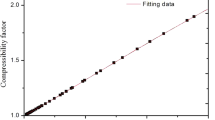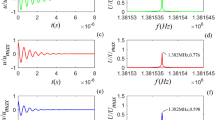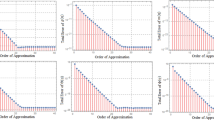Abstract
ACCURATE measurements of the velocity of sound in a gas, combined with a good equation of state, can yield precise values for the specific heats of the gas. Standing-wave velocity measurements in a tube are complicated by the Helmholtz-Kirchhoff effect which leads to attenuation and a lowered velocity, and by thermal relaxation which causes further attenuation but increase in velocity. It has been shown theoretically1 that at low audible frequencies the attenuations add linearly while the velocity is the relaxation velocity multiplied by the usual Helmholtz-Kirchhoff factor2, that is:  where α is the total attenuation, v the measured velocity, f the frequency of oscillation, and αHK = gf
½, and αr = Hτf
2 where g is a function of tube radius, viscosity and thermal conductivity, H a function of the principal specific heats and τ the relaxation time. At frequencies such that 2πfτ ≪ 1, the relaxation velocity v
r reduces to the free space velocity at zero frequency v
0. Using the apparatus described by Harlow3, measurements were made on pure carbon dioxide, pure oxygen and dry air free from carbon dioxide of the velocity of sound and corresponding attenuation at frequencies between 100 and 1,500 cycles sec.−1, at a pressure of one atmosphere and temperature of 30° C. By plotting v
−1 against f−½ straight line graphs were obtained and the values of v
0 and g determined. Graphs of αf
−½ against f
3/2 yielded values for g and Hτ. These values are given in Table 1 together with the theoretical values of g and H and the value of τ in the samples used.
where α is the total attenuation, v the measured velocity, f the frequency of oscillation, and αHK = gf
½, and αr = Hτf
2 where g is a function of tube radius, viscosity and thermal conductivity, H a function of the principal specific heats and τ the relaxation time. At frequencies such that 2πfτ ≪ 1, the relaxation velocity v
r reduces to the free space velocity at zero frequency v
0. Using the apparatus described by Harlow3, measurements were made on pure carbon dioxide, pure oxygen and dry air free from carbon dioxide of the velocity of sound and corresponding attenuation at frequencies between 100 and 1,500 cycles sec.−1, at a pressure of one atmosphere and temperature of 30° C. By plotting v
−1 against f−½ straight line graphs were obtained and the values of v
0 and g determined. Graphs of αf
−½ against f
3/2 yielded values for g and Hτ. These values are given in Table 1 together with the theoretical values of g and H and the value of τ in the samples used.
This is a preview of subscription content, access via your institution
Access options
Subscribe to this journal
Receive 51 print issues and online access
$199.00 per year
only $3.90 per issue
Buy this article
- Purchase on Springer Link
- Instant access to full article PDF
Prices may be subject to local taxes which are calculated during checkout
Similar content being viewed by others
References
Wintle, H. J., M.Sc. Thesis, London (1959) ; Smith, D. H., and Wintle, H. J. (to be published).
Rayleigh, “Theory of Sound” (1894).
Harlow, R. G., Ph.D. Thesis, London (1954).
Beattie, J. A., and Stockmayer, W. H., Rep. Prog. Phys., 7, 195 (1940).
Michels, A., and Michels, C., Proc. Roy. Soc., A, 160, 348 (1937).
Meyers, C. H., J. Res. Nat. Bur. Std., 40, 457 (1948).
Woolley, H. W., J. Res. Nat. Bur. Std., 40, 163 (1948).
Woolley, H. W., J. Res. Nat. Bur. Std., 52, 289 (1954).
Masi, J. F., and Petkof, B., J. Res. Nat. Bur. Std., 48, 179 (1952).
Lee, T. A., Ph.D. Thesis, London (1957).
Author information
Authors and Affiliations
Rights and permissions
About this article
Cite this article
WINTLE, H. Velocity of Sound in Relaxing Gases. Nature 184, 2007–2008 (1959). https://doi.org/10.1038/1842007a0
Issue Date:
DOI: https://doi.org/10.1038/1842007a0
Comments
By submitting a comment you agree to abide by our Terms and Community Guidelines. If you find something abusive or that does not comply with our terms or guidelines please flag it as inappropriate.



